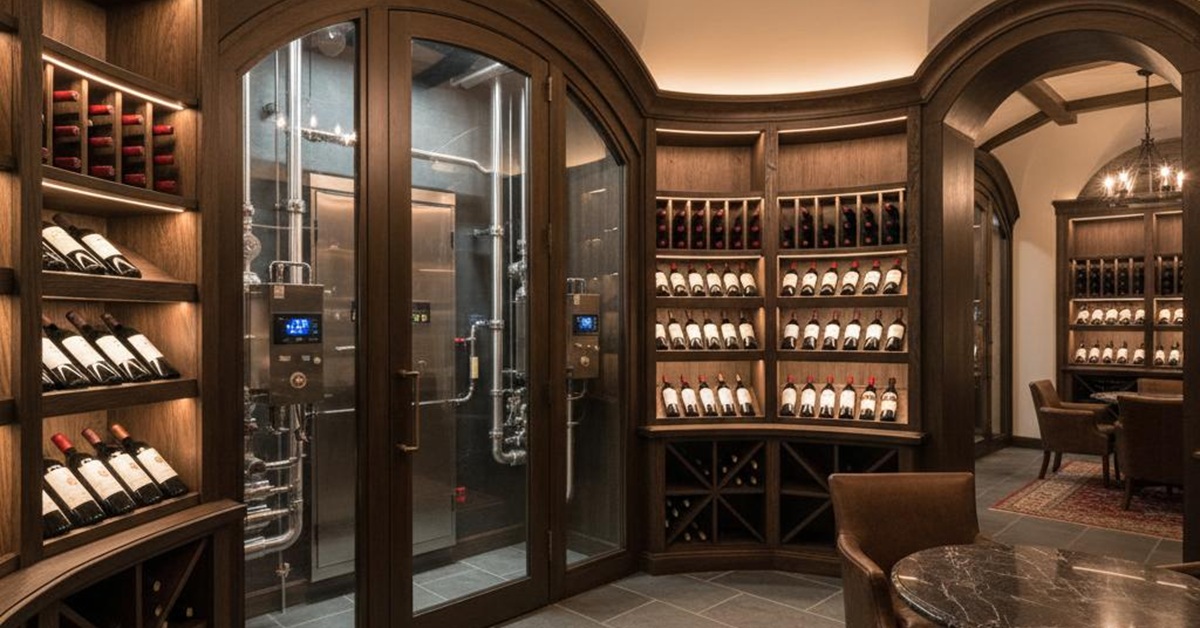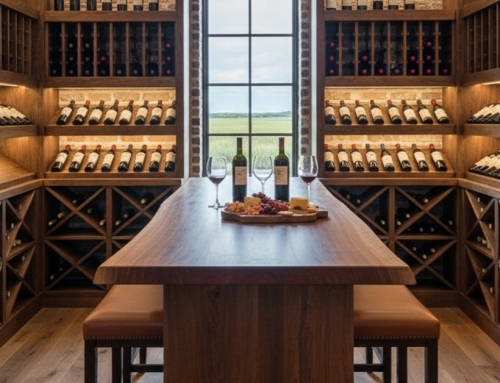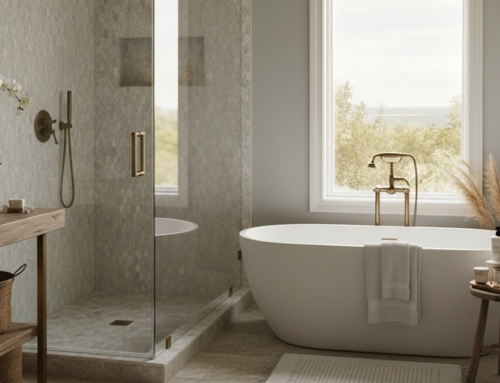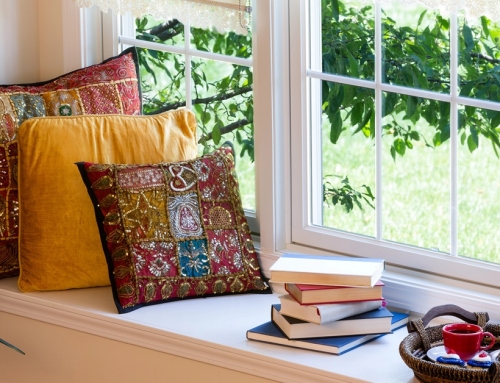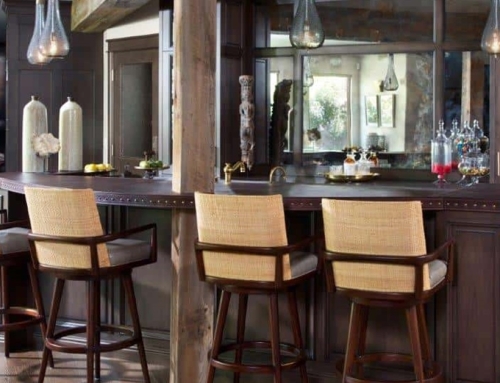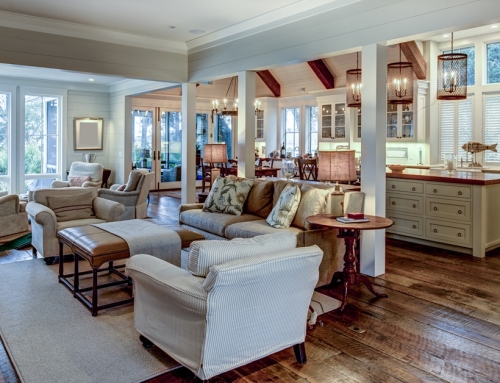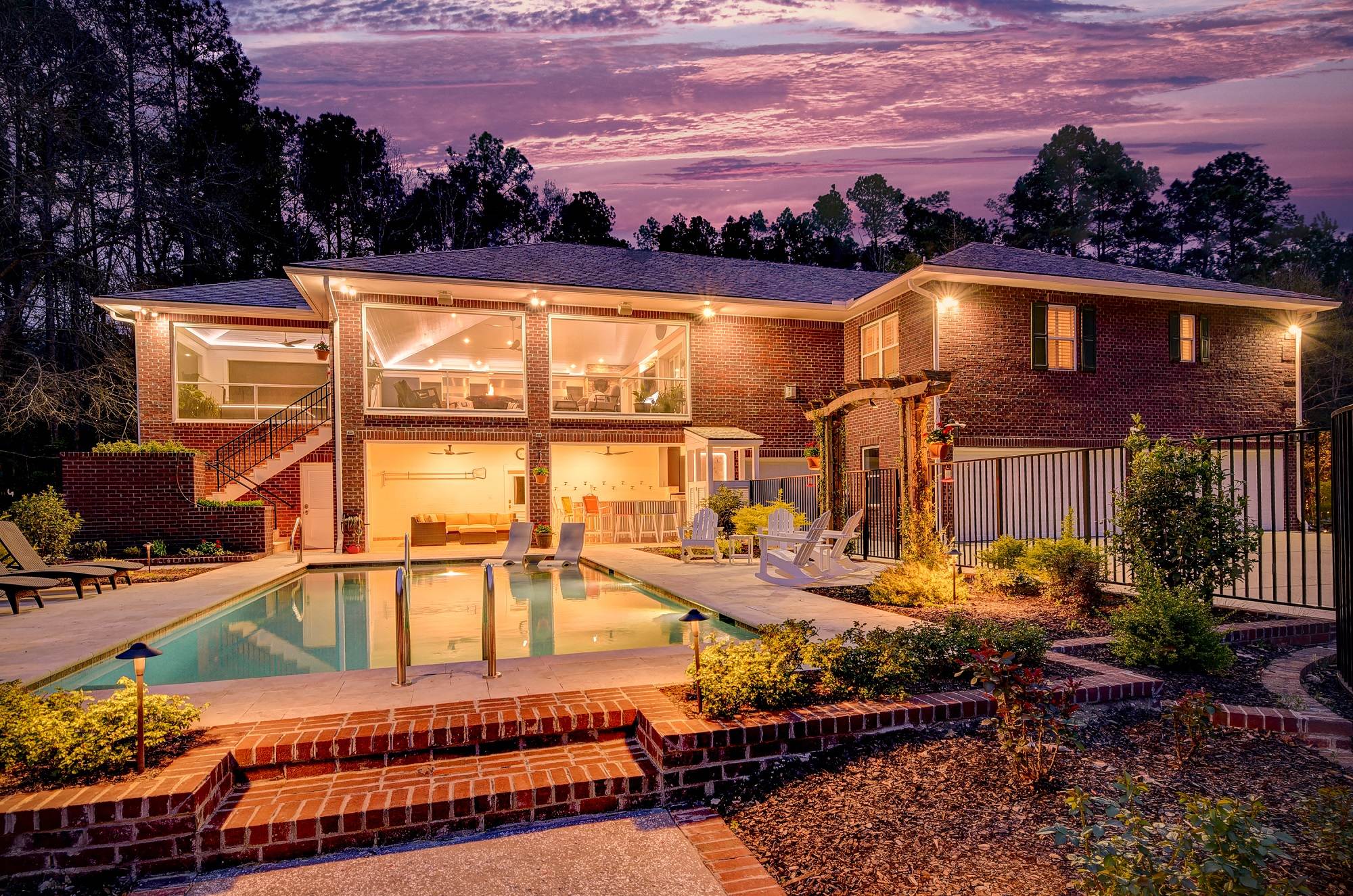Few additions to the home speak to sophistication and lifestyle quite like a professionally designed wine cellar. As autumn settles over Hilton Head Island, Bluffton, and Beaufort, October presents the perfect time to begin planning a luxury wine cellar that will be ready for enjoyment by spring. With the complexity of climate control systems, custom millwork, and specialized storage solutions, the six- to eight-month timeline required for a premium wine cellar renovation aligns perfectly with starting your project now.
At Winslow Design Studio, we understand that a wine cellar is far more than storage – it’s a reflection of your passion for fine wines and an extension of your entertaining lifestyle. Whether you’re converting an existing space or creating a new cellar from scratch, the planning phase is crucial for ensuring your investment protects your collection while creating a stunning showcase for your wines.
Understanding the Fundamentals of Wine Cellar Design
Creating the perfect wine cellar requires balancing multiple technical and aesthetic elements. The foundation of any successful wine cellar lies in understanding how environmental factors affect wine storage and how proper design can create optimal conditions for your collection.
Temperature Control: The Heart of Wine Preservation
Wine storage requires consistent temperatures between 55-58 degrees Fahrenheit, with minimal fluctuation throughout the year. The Lowcountry’s humid subtropical climate presents unique challenges that make professional climate control systems essential. Unlike standard HVAC systems, wine cellar cooling units are specifically designed to maintain the precise temperature and humidity levels that protect your investment.
Modern wine cellar cooling systems offer sophisticated controls that monitor and adjust conditions automatically. These systems can be integrated into your home’s smart technology, allowing you to monitor your cellar’s conditions remotely and receive alerts if any parameters drift outside optimal ranges.
Humidity Management in Coastal Environments
The Lowcountry’s naturally high humidity levels require careful management in wine cellar design. While wine storage benefits from 60% to 70% humidity to prevent cork drying, excessive moisture can damage labels and promote mold growth. Professional-grade dehumidification systems work in conjunction with cooling units to maintain ideal conditions year-round.
Proper vapor barriers and insulation are critical components that prevent moisture intrusion from surrounding areas. This is particularly important in coastal environments where humidity levels can fluctuate dramatically with weather patterns and seasonal changes.
Get Started Now for Spring Completion
Beginning your wine cellar project now provides the ideal timeline for spring completion, allowing you to enjoy your new space as entertaining season begins. This timing also offers several practical advantages for both planning and construction.
Design Development and Permit Process
The initial design phase typically requires six to eight weeks to develop comprehensive plans that address all technical and aesthetic requirements. This includes detailed engineering for climate control systems, electrical planning for proper lighting and controls, and coordination with structural requirements for racking systems.
Local building permits for wine cellars often require detailed plans showing climate control specifications, electrical layouts, and structural modifications. Starting now allows ample time for permit approval and any required revisions without delaying construction timelines.
Material Selection and Custom Millwork
Luxury wine cellars often feature custom millwork and specialized materials that require extended lead times. Premium wood species for racking, custom glass doors, and specialized hardware may need 12-16 weeks for fabrication and delivery. Beginning material selection in October ensures availability for spring installation.
The partnership between Winslow Design Studio and Kessick Wine Cellars provides access to premium racking systems and custom storage solutions that are manufactured to exact specifications. This collaboration ensures that every element of your cellar is designed and built to the highest standards.
Climate Control Systems: Technology Meets Tradition
Modern wine cellar climate control represents a sophisticated integration of technology and traditional wine storage principles. Understanding these systems helps homeowners make informed decisions about their cellar’s mechanical requirements.
Cooling Unit Selection and Sizing
Proper cooling unit sizing depends on multiple factors including cellar volume, insulation quality, glass area, and ambient conditions. Undersized units work constantly and fail prematurely, while oversized units cycle too frequently and fail to maintain consistent humidity levels.
Professional load calculations consider the Lowcountry’s specific climate challenges, including high ambient temperatures and humidity levels. These calculations ensure your cooling system operates efficiently while maintaining optimal storage conditions throughout the year.
Backup Systems and Monitoring
Protecting valuable wine collections requires redundant systems and comprehensive monitoring. Modern installations often include backup cooling systems that activate automatically if primary units fail. Remote monitoring systems provide real-time alerts to your smartphone if any conditions drift outside acceptable parameters.
Battery backup systems ensure that monitoring and alert systems continue functioning during power outages, providing peace of mind during severe weather events that are common in coastal South Carolina.
Storage Solutions: Maximizing Capacity and Accessibility
Effective wine cellar design balances maximum storage capacity with easy access to your collection. Modern racking systems offer sophisticated solutions that accommodate different bottle sizes while creating an impressive visual display.
Custom Racking Systems
Traditional wooden racking remains popular for its aesthetic appeal and natural insulation properties. Premium hardwoods like mahogany, cherry, and walnut provide durability while complementing the cellar’s overall design aesthetic. These materials also naturally regulate humidity and provide excellent insulation properties.
Metal racking systems offer contemporary aesthetics with superior durability and easier maintenance. Powder-coated finishes resist corrosion in humid environments while providing clean, modern lines that complement contemporary home designs.
Specialized Storage Features
Modern wine cellars incorporate specialized storage solutions for diverse types of bottles and collections. Champagne riddling racks add authentic cellar character while providing proper storage for sparkling wines. Display shelving showcases special bottles while keeping them easily accessible for entertaining.
Bulk storage areas accommodate cases of everyday wines while keeping them organized and accessible. These areas often feature removable dividers that adapt to changing collection needs over time.
Lighting Design: Showcasing Your Collection
Proper lighting transforms a wine cellar from simple storage into an impressive showcase while protecting wines from harmful UV radiation. LED technology has revolutionized wine cellar lighting by providing energy-efficient illumination without heat generation.
LED Lighting Systems
Modern LED systems offer precise color temperature control that enhances the visual appeal of wine labels and bottle colors without producing harmful UV radiation. Warm color temperatures (2700K-3000K) create inviting ambiance while cool temperatures (4000K+) provide task lighting for reading labels and selecting bottles.
Programmable lighting controls allow you to create different lighting scenes for various activities – bright illumination for inventory management, subtle accent lighting for entertaining, and security lighting for after-hours monitoring.
Accent and Display Lighting
Strategic accent lighting highlights architectural features and creates visual interest throughout the cellar. Under-shelf lighting illuminates bottle labels while creating dramatic shadows that add depth and character to the space.
Display case lighting highlights special bottles and creates focal points that draw attention to prized selections. These systems often include adjustable spotlights that can be repositioned as collections change and grow.
Architectural Elements and Design Aesthetics
Wine cellars provide opportunities to incorporate dramatic architectural elements that create memorable spaces for entertaining and personal enjoyment. The design should reflect your personal style while complementing your home’s overall aesthetic.
Entry Design and Security
The entrance to your wine cellar sets the tone for the entire experience. Custom glass doors with specialized sealing systems maintain climate control while providing visual access to the collection. Security features can be integrated discreetly to protect valuable collections without detracting from the aesthetic appeal.
Traditional wooden doors offer classic elegance and superior insulation properties. These can be customized with decorative hardware, glass panels, and specialized locking systems that provide both security and style.
Flooring and Wall Treatments
Wine cellar flooring must withstand humidity while providing stable footing and easy maintenance. Natural stone, ceramic tile, and sealed concrete offer durability while complementing various design aesthetics. Radiant heating systems can be integrated into flooring to provide supplemental warmth and prevent condensation.
Wall treatments range from traditional stone and brick to modern materials like reclaimed wood and metal panels. These materials should complement the overall design while providing proper insulation and vapor barrier properties.
Integration with Home Entertainment Systems
Modern wine cellars often serve as entertainment spaces that integrate with the home’s overall technology systems. Planning for these integrations during the design phase ensures seamless operation and maximum enjoyment.
Audio and Visual Systems
Discrete audio systems allow you to enjoy music while selecting wines or entertaining guests in the cellar. Moisture-resistant speakers and controls ensure reliable operation in humid environments while maintaining the space’s aesthetic integrity.
Digital inventory systems help manage large collections while providing information about optimal drinking windows and storage locations. These systems can integrate with smartphone apps for convenient access to collection information.
Tasting Areas and Seating
Incorporating tasting areas within or adjacent to the wine cellar creates opportunities for intimate tastings and small gatherings. These areas require careful climate control to ensure guest comfort while maintaining proper storage conditions for the wine collection.
Custom furniture designed for wine cellars provides comfortable seating while withstanding humidity and temperature variations. Materials like teak, cedar, and specially treated fabrics offer durability while maintaining comfort and style.
Maintenance and Long-Term Care
Proper maintenance ensures your wine cellar continues protecting your collection while operating efficiently for decades. Understanding maintenance requirements during the design phase helps ensure long-term success and enjoyment.
System Maintenance Schedules
Climate control systems require regular maintenance to ensure optimal performance and longevity. Professional service schedules typically include quarterly inspections, annual deep cleaning, and periodic refrigerant checks. Establishing maintenance relationships during installation ensures continued expert care.
Monitoring system calibration and backup battery replacement should be scheduled annually to ensure continued protection of your collection. These preventive measures help avoid costly emergency repairs and potential collection losses.
Collection Management
Proper wine cellar design includes systems for inventory management and rotation that help you enjoy your collection at optimal times. Digital inventory systems can track purchase dates, optimal drinking windows, and storage locations within the cellar.
Regular collection assessment helps identify wines that should be consumed soon while planning for future acquisitions. This ongoing management ensures you maximize enjoyment from your investment in both the cellar and the collection.
Working with Design Professionals
Creating a luxury wine cellar requires coordination between multiple specialists including designers, climate control engineers, and custom millwork craftsmen. The professional design team at Winslow Design Studio ensures all elements work together seamlessly while meeting your specific needs and preferences.
Design Process and Timeline
The professional design process begins with detailed consultation to understand your collection size, entertaining preferences, and aesthetic goals. This information guides the development of preliminary concepts that balance technical requirements with design objectives.
Detailed engineering follows concept approval, addressing all mechanical, electrical, and structural requirements. This phase typically requires four to six weeks and results in comprehensive construction documents that guide the installation process.
Coordination and Project Management
Wine cellar construction requires careful coordination between climate control installation, electrical work, and finish carpentry. Professional project management ensures these trades work efficiently together while maintaining quality standards throughout the process.
Regular progress meetings and quality inspections ensure the project stays on schedule while meeting all technical and aesthetic requirements. This professional oversight protects your investment while ensuring optimal results.
Investment Considerations and Value
A professionally designed wine cellar represents a significant investment that provides both personal enjoyment and potential property value enhancement. Understanding these financial aspects helps inform design decisions and budget planning.
Cost Factors and Budget Planning
Wine cellar costs vary significantly based on size, complexity, and finish quality. Climate control systems, custom millwork, and specialized storage solutions represent the largest cost components. Professional design teams help optimize these investments to achieve maximum value and functionality.
Long-term operating costs including energy consumption and maintenance should be considered during the planning phase. Energy-efficient systems and quality construction minimize these ongoing expenses while ensuring reliable operation.
Property Value Enhancement
Well-designed wine cellars can enhance property values, particularly in luxury markets like the Lowcountry where wine appreciation is common among homeowners. Professional design and installation documentation supports these value claims during property appraisals.
The key to value enhancement lies in professional design and installation that meets current building codes and industry standards. This professional approach ensures the cellar adds value rather than creating potential liabilities.
Creating Your Dream Space
Creating the perfect wine cellar requires careful planning, professional expertise, and attention to countless details that affect both functionality and aesthetics. Starting your project in the fall provides the ideal timeline for spring completion, allowing you to begin enjoying your new cellar as entertaining season arrives.
The investment in a professionally designed wine cellar extends far beyond simple storage – it creates a space for entertaining, relaxation, and personal enjoyment that enhances your lifestyle while protecting your wine collection. The technical complexity of climate control, storage systems, and architectural integration requires professional expertise to ensure optimal results.
At Winslow Design Studio, our partnership with Kessick Wine Cellars and our extensive experience with Lowcountry homes ensures your wine cellar project receives the professional attention it deserves. From initial concept through final installation, our team coordinates all aspects of the project to deliver exceptional results that exceed your expectations.
Whether you’re planning an intimate cellar for personal collection or a grand space for entertaining, the key to success lies in beginning with professional design expertise that addresses all technical and aesthetic requirements. Your wine collection deserves protection in a space that reflects your passion and enhances your enjoyment of fine wines.
Ready to begin planning your dream wine cellar? Talk to a design expert at Winslow Design Studio to explore how we can create the perfect climate-controlled collection space that will be ready for your enjoyment by spring.


